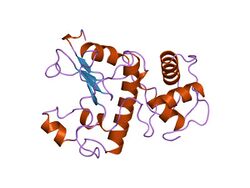Biology:Peptidoglycan binding domain
| Putative peptidoglycan binding domain | |||||||||||
|---|---|---|---|---|---|---|---|---|---|---|---|
 Structure of Streptomyces Albus muramoyl-pentapeptide carboxypeptidase.[1] | |||||||||||
| Identifiers | |||||||||||
| Symbol | PG_binding_1 | ||||||||||
| Pfam | PF01471 | ||||||||||
| Pfam clan | CL0244 | ||||||||||
| InterPro | IPR002477 | ||||||||||
| SCOP2 | 1lbu / SCOPe / SUPFAM | ||||||||||
| |||||||||||
Peptidoglycan binding domains have a general peptidoglycan binding function and a common core structure consisting of a closed, three-helical bundle with a left-handed twist. It is found at the N or C terminus of a variety of enzymes involved in bacterial cell wall degradation.[2][3][4] Examples are:
- Muramoyl-pentapeptide carboxypeptidase (EC 3.4.17.8)
- N-acetylmuramoyl-L-alanine amidase cwlA precursor (cell wall hydrolase, autolysin, EC 3.5.1.28)
- Autolytic lysozyme (1,4-beta-N-acetylmuramidase, autolysin, EC 3.2.1.17)
- Membrane-bound lytic murein transglycosylase B
- Zinc-containing D-alanyl-D-alanine-cleaving carboxypeptidase, VanX.[5]
Many of the proteins having this domain are as yet uncharacterised. However, some are known to belong to MEROPS peptidase family M15 (clan MD), subfamily M15A metallopeptidases. A number of the proteins belonging to subfamily M15A are non-peptidase homologues as they either have been found experimentally to be without peptidase activity, or lack amino acid residues that are believed to be essential for the catalytic activity.
Eukaryotic enzymes can contain structurally similar PGBD-like domains. Matrix metalloproteinases (MMP), which catalyse extracellular matrix degradation, have N-terminal domains that resemble PGBD. Examples are gelatinase A (MMP-2), which degrades type IV collagen,[6] stromelysin-1 (MMP-3), which plays a role in arthritis and tumour invasion,[7][8] and gelatinase B (MMP-9) secreted by neutrophils as part of the innate immune defence mechanism.[9] Several MMPs are implicated in cancer progression, since degradation of the extracellular matrix is an essential step in the cascade of metastasis.[10]
Examples
Humans genes encoding proteins containing this domain include:
- MMP1, MMP2, MMP3, MMP7, MMP8, MMP9,
- MMP10, MMP12, MMP13, MMP14, MMP15, MMP16, MMP17, MMP19,
- MMP20, MMP21, MMP24, MMP25, MMP27, MMP28
References
- ↑ PDB: 1lbu
- ↑ "Lysis genes of the Bacillus subtilis defective prophage PBSX". J. Bacteriol. 180 (8): 2110–2117. 1998. doi:10.1128/JB.180.8.2110-2117.1998. PMID 9555893.
- ↑ "Structure of a Zn2+-containing D-alanyl-D-alanine-cleaving carboxypeptidase at 2.5 A resolution". Nature 299 (5882): 469–470. 1982. doi:10.1038/299469a0. PMID 7121588. http://orbi.ulg.ac.be/handle/2268/77995.
- ↑ Foster SJ (1991). "Cloning, expression, sequence analysis and biochemical characterization of an autolytic amidase of Bacillus subtilis 168 trpC2". J. Gen. Microbiol. 137 (8): 1987–1998. doi:10.1099/00221287-137-8-1987. PMID 1683402.
- ↑ "Active-site-directed inactivators of the Zn2+-containing D-alanyl-D-alanine-cleaving carboxypeptidase of Streptomyces albus G". Biochem. J. 219 (3): 763–772. 1984. doi:10.1042/bj2190763. PMID 6743245.
- ↑ Seiki M (1999). "Membrane-type matrix metalloproteinases". APMIS 107 (1): 137–143. doi:10.1111/j.1699-0463.1999.tb01536.x. PMID 10190290.
- ↑ "Analysis of the cell infiltrate and expression of proinflammatory cytokines and matrix metalloproteinases in arthroscopic synovial biopsies: comparison with synovial samples from patients with end stage, destructive rheumatoid arthritis". Ann. Rheum. Dis. 62 (7): 635–638. 2003. doi:10.1136/ard.62.7.635. PMID 12810425.
- ↑ "Proteolyzed matrix as a template for the regulation of tumor progression". Biomed. Pharmacother. 57 (5–6): 223–230. 2003. doi:10.1016/S0753-3322(03)00049-0. PMID 12888258.
- ↑ "Gelatinase B/MMP-9 and neutrophil collagenase/MMP-8 process the chemokines human GCP-2/CXCL6, ENA-78/CXCL5 and mouse GCP-2/LIX and modulate their physiological activities". Eur. J. Biochem. 270 (18): 3739–3749. 2003. doi:10.1046/j.1432-1033.2003.03760.x. PMID 12950257.
- ↑ "Recent advances in the regulation of matrix metalloproteinase 2 activation: from basic research to clinical implication (Review)". Oncol. Rep. 9 (3): 607–611. 2002. doi:10.3892/or.9.3.607. PMID 11956636.
 |

